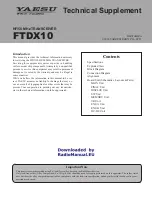
19
20
3.2.2 Search for short circuit in the circuit
Preconditions:
The circuit must be uncharged;
※
Connect the transmitter according to Fig.3-2-2;
※
The measuring method is the same as that shown in the example.
※
1 .If there is current in the cable, cut off the power first to turn it into an uncharged
state.
2. When searching for short circuits of coated electric wires and cables, the depths
of detection vary as the core wires are twisted together in the jacket. According
to experience, only the short circuits with the impedance lower than 20 ohm can
be correctly detected. The impedance of short circuit can be measured with a
multimeter.
1.If the impedance of short circuit is higher than 20 ohm, try to use the method to
search for breakage in circuit to search for the short circuit In order to do that,
use a relatively high current to temporarily connect the part with flaw (low ohm
connection) or break it.
2.ln the process of detecting along the pipeline, if the signals received by the
receiver is suddenly attenuated, the detected position is where the short circuit
locates.
3.Adjust the transmitting power of the transmitter to adapt to different radiuses of
detection.
4.Select the manual mode on the receiver and select suitable receiving sensitivity
to precisely locate the circuit.
3.2.3 Applications in closed circuits
It can be applied to charged circuits and uncharged circuits:
In uncharged circuits, the transmitter only sends encoding signals to the circuit to be
detected.
In charged circuits, the transmitter not only sends encoding signals to the circuit to be
detected, but also measures and displays the voltage of the charged circuit. As shown
in Fig.3-2-3:
When connecting charged circuits to the
transmitter, please do abide by the safety
instructions.
1.The dielectric strength of the transmitter is 400V AC/DC.
2.The closed circuit application is suitable for searching sockets, switches and
fuses, etc, in the electrical installations of charged or uncharged floors.
3.The depth of detection is related to the media of the cable laid and the way of
usage, and the common depth of detection is shorter than 0.5m.
Fig 3-2-2
Fig 3-2-3
Your excellent helper in measuring instruments
.
Your excellent helper in measuring instruments
.
CAUTIONS
HINTS
HINTS
WARNING


































